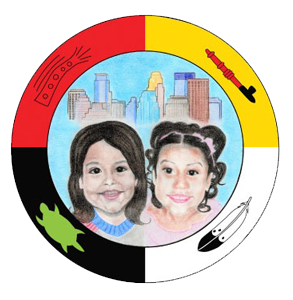History
In 1998, the Alliance of Early Childhood Professionals (AECP) began the Taking the Lead leadership project. Seven Leadership Circles formed to make systems changes in early childhood for the betterment of the children in underrepresented communities. Each Leadership Circle consisted of people from the specific community who were early childhood educators.
These circles were
– The African American Leaders’ Circle
– The Somali Leaders’ Circle
– The Sudanese Leaders’ Circle
– Hmong Leaders’ Circle
– The Latino Leaders’ Circle
– The Men’s Leaders’ Circle
– The Native American Leaders’ Circle
The Native American Leaders’ Circle consisted of Early Childhood Educators that all worked in South Minneapolis. For two years they struggled to maintain a consistent, solid group and decide what issues they were to focus on.
In the year 2000, with the support of the Alliance of Early Childhood Professionals, the Native American Leaders’ Circle held a conference called In the Spirit of the Child in Mille Lacs, MN. Teachers along with Legislative, Tribal and community leaders came from around the state of Minnesota to discuss what were the community’s concerns for their children.
The issues that were most acknowledged were the loss of language and a lack of curriculum for younger children. These then became the foci and motivating factors for the Native American Leaders’ Circle. The participants of the Leaders’ Circle decided that they were going to have language speakers in each of their respective early childhood classrooms. But, they needed financial support to do so.
So, in 2002, AECP Native Leaders circle started the Dakota Ojibwe Language Revitalization Alliance (DOLRA) was formed. DOLRA was a support group for people working in language revitalization efforts to network and share ideas. Members of the Leaders’ Circle traveled to each of the Dakota Communities and Ojibwe Reservations to talk about the work that needed to be done and increase participation in DOLRA. They wanted to have all of the tribes represented at DOLRA’s monthly meetings as well as gain support for the work that DOLRA did.
While the DOLRA members met, the members of the Leaders’ Circle cooked food. They would cook and the people would come. DOLRA then approached all of the Tribes and the State of Minnesota to have a resolution passed to support language work in Minnesota. This bill was passed in 2006 with the help of language champion and then state representative Karen Clark.
The Native American Leaders’ Circle had a core group of seven women. These women were Lillian Rice, Jennifer Bendickson, Betty Bowstring, Betty Jane Schaaf, Tammy Shaw, Leila Goggleye and Vicky Chavez.
Then, in 2006, the Native American Leaders’ Circle began the Dakota and Ojibwe Immersion Program, Wicoie Nandagikendan. There were five classrooms, each associated with at least one of the Leaders’ Circle’s members. Of those sites, one is still in existence in collaboration with The Family Partnerships Four Directions Early Childhood program, Wicoie Nandagikendan currently has one Dakota full Immersion classroom and one Ojibwe full immersion classroom.
In 2007, DOLRA secured ongoing state funding for language teacher training through the University of Minnesota Duluth and Twin Cities.
During both the 2009-2010 and the 2011-2012 state legislative sessions DOLRA secured Legacy money to continue supporting language revitalization efforts. We have continued to receive legacy funds up into the 2017-19 biennium.
Wicoie Nandagikendan uses a master/apprentice model and since 2006 we have assisted in developing upwards of 50 language immersion teachers.
Wicoie Nandagikendan is continuing language revitalization at the early childhood level with our children, their families and our Dakota and Ojibwe languages being at the center of the work we do in the community.
Meet Our Team